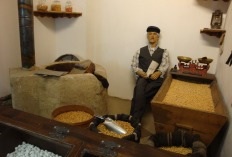Çorum‘s excellent museum (closed Mondays) is housed in building designed as a hospital in 1914 and later used as a school. Pick up the excellent free sound guide (Turkish or English) at the front desk as it will help make better sense of the archaeological displays relating mainly to the Hattis and Hittites downstairs, and to the Romans and Phrygians upstairs.
Especially interesting are the reconstructions of a Hatti jar burial and of a Hittite royal burial from Alaca Höyük. Also impressive are two huge vases carved with scenes of bull dancing and musicians that came from a site at Hüseyindede, north-east of Çorum. They are reminiscent of a similar vase in the Çankırı museum.
Those who will be going on to visit Hattuşa will find the scale model of the site very useful. There is also an enlightening model of how the Hittites constructed their mud-brick and wooden walls on foundations of stone.
Upstairs are displayed finds from Şapınuva, near Ortaköy, as well as some delicately patterned Phrygian panels similar to those found at Gordion. Amid the Roman glassware look out for the vials in which professional funeral criers would carry tears.
The museum’s basement houses a small but worthwhile ethnographic collection with models of a village “kahve (tea house)”, a shop where chickpeas were roasted and a copper-beater’s workshop. Here, too, are displayed some fine costume pieces, a wooden frieze decorated with vines and removed from a local church, and two sets of wooden doors salvaged from local mosques.
The grounds contain a selection of old tombstones, Roman milestones and giant storage jars, as well as a Byzantine marble throne.
A café and gift shop by the gate are welcome extras.

